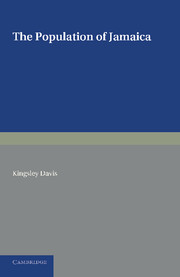Book contents
- Frontmatter
- The Conservation Foundation
- Contents
- List of Figures
- List of Tables
- Preface
- INTRODUCTION
- CHAPTER 1 DEMOGRAPHIC MATERIAL AVAILABLE
- CHAPTER 2 GROWTH OF THE POPULATION
- CHAPTER 3 MAJOR CHARACTERISTICS OF THE POPULATION
- CHAPTER 4 CURRENTS OF EXTERNAL MIGRATION
- CHAPTER 5 INTERNAL MIGRATION
- CHAPTER 6 MORTALITY
- CHAPTER 7 CHANGING PATTERNS OF REPRODUCTION
- CHAPTER 8 FERTILITY, MATING AND ILLEGITIMACY
- CHAPTER 9 GROWTH PROSPECTS
- APPENDICES
- Index of Names
- Index of Subjects
CHAPTER 9 - GROWTH PROSPECTS
Published online by Cambridge University Press: 05 June 2016
- Frontmatter
- The Conservation Foundation
- Contents
- List of Figures
- List of Tables
- Preface
- INTRODUCTION
- CHAPTER 1 DEMOGRAPHIC MATERIAL AVAILABLE
- CHAPTER 2 GROWTH OF THE POPULATION
- CHAPTER 3 MAJOR CHARACTERISTICS OF THE POPULATION
- CHAPTER 4 CURRENTS OF EXTERNAL MIGRATION
- CHAPTER 5 INTERNAL MIGRATION
- CHAPTER 6 MORTALITY
- CHAPTER 7 CHANGING PATTERNS OF REPRODUCTION
- CHAPTER 8 FERTILITY, MATING AND ILLEGITIMACY
- CHAPTER 9 GROWTH PROSPECTS
- APPENDICES
- Index of Names
- Index of Subjects
Summary
As the island completes its third century of British rule it stands poised, apparently, for population growth on a scale greater than anything it has experienced in the past. The third century, unlike the one preceding it, has been characterized by unbroken population growth, which, though varying slightly from one intercensal interval to another, has remained, by comparison with other West Indian colonies, very stable. The annual rate of growth during the first intercensal interval, 1844–61, amounted to 0.9%, and this increased to 1.4% during the period 1861–81. A decline to under 1% was witnessed between 1881 and 1891, but in the succeeding intercensal interval the rate rose once more, to 1.3%. It was only during 1911—21, when emigration was on a relatively heavy scale and mortality conditions unfavourable, that a very low rate of growth prevailed (0.3%). However, the appreciable declines in mortality after 1921 and the cessation of emigration resulted in a considerably higher rate of growth, even in the face of some declines in fertility. The annual rate of growth during 1921–43 was the highest ever recorded (1.67%). Present rates of growth are much higher than any experienced in the past. Indeed since 1950 the island has consistently shown rates of natural increase in excess of 2% which, despite some emigration, results in a rate of growth nearly twice that prevailing in the middle of the nineteenth century.
It is easy to show that the continuation of a rate of increase of 2% over even a moderate length of time will yield massive additions to the population. Growth at such a rate would mean a population of 3.8 million within 50 years—that is more than the present population of the whole British Caribbean—while within a century a population of over 10 million would be massed in the island. Even a continuation of the more modest intercensal rate of 1921–43 (1.7%) would, if continued, yield totals hardly less impressive. Within 50 years the island population would amount to 3.3 million and within a century to 7.5 million.
- Type
- Chapter
- Information
- The Population of Jamaica , pp. 307 - 329Publisher: Cambridge University PressPrint publication year: 2013



